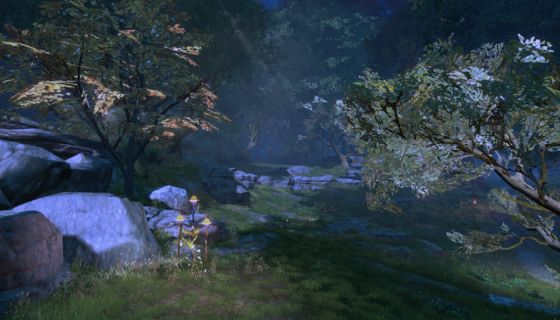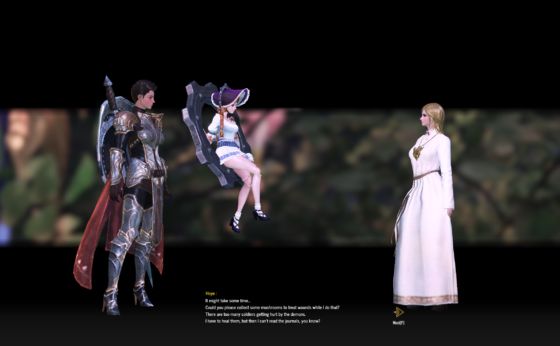Little slices of sunlight dance along the grass. The hints of light pierce through the canopy above, painting abstract patterns as the leaves rustle in the wind. An armored boot crushes the grass, as a warrior spins, slashing their blade violently across an Orc’s unarmored flesh. Blood spatters the greenery, shouts of combat rupture the soft whisper of the forest, and the leaves continue their dance.
This is the state of the world of Astellia. Warriors battle demons, celestial beings known as Astels are controlled by the human forces to give hope against powerful demons, colossal golems are summoned and controlled as part of this war, and the hope for this conflict lands on the lap of long-dormant celestial masters known as Astellians, who can summon and use several Astels at once.
This is where Astellia begins. Players start as new Astellians, coming to grips with their new powers, setting off on quests and helping humanity along the road, and finding several Astels to grow their power in hopes of bringing this war to a close.
Gameplay - 6 / 10
This conflict, and each player’s part in it, will be familiar to anyone who’s played an online game in the past decade. Players choose between one of five classes: Warrior (Tank), Assassin (Melee DPS), Archer (Ranged DPS), Mage (Magic DPS), and Scholar (Healer Mage). Each of these classes have upgrade lines (though at time of writing, are not yet accessible), each has unique armor and weapon sets, unique skills, and all play slightly differently.
In combat, the game plays out in the usual online fashion. The character attacks at a set speed, but each automatic attack can be interrupted by selecting a skill, which can have varying effects to opponents such as instilling status effects, bleed, stun, knock down, etc.
The biggest change to an otherwise standard MMORPG formula is the presence of Astels, who are independent NPCs who follow along with the player and attack and have skills that assist the player character. Astels are powered by a third MP bar. The first can remain on the field indefinitely, but any additional Astel called on the field drains the player’s bar, and once drained, all non-primary Astels leave the field until re-summoned.
Each Astel has an automatic attack, a passive action (buff, shield, heal, etc.), and a skill—often a buff or attack—the player can choose to use. Astels serve a similar role to pets in many other games, and boil down to more or less the same. The variety of Astels means players have a lot of choices to pick from once they’re unlocked, but the limited amount of Astellian energy keeps the Astel system from really breaking the mold.
In practice, combat and gameplay in Astellia is very familiar, very formulaic, and not particularly noteworthy.
 Innovation - 4 / 10
Innovation - 4 / 10
The presence of Astels about as interesting as choices come in Astellia. Because players aren’t strictly limited on how many Astels they can choose to run with, at least for a few minutes at a time, combat can gain some really interesting layers when mixing and matching which Astels are out, which Astel abilities the players elect to use in any given fight, and especially when paired with the player skills.
That said, it rarely goes beyond “Interesting Thought Experiment” territory. While the way the Astel can interact is neat, it’s hardly needed. In combat, players have a handful of skills that are optimized for damage output, and those skills are the best ones to choose. Certain Astels can heal or buff, and those choices are almost always going to be the best passive choices because player damage output is high enough to render purely damage-dealing Astels not very satisfying.
And, independent of neat Astel concepts, combat is just kind of there. Go to point X, fight Y number of enemies, pick up items, turn in items to quest NPC, gain experience, move to next NPC just up the road. The maps are strictly linear, and drive the players in a straight line along the plot corridor, with little variation to the formula. Arriving at the next map means a new setting in which to go to point X, fight Y enemies, pick up items, turn in to quest NPC, and gain experience.
Lather, rinse, repeat.
Community - 7 / 10
Where Astellia fails to impress with its story beats and mechanical structures, it has at least a solid playerbase. Most players are friendly enough, there’s polite chatter in the global messages, and there are a wide range of guilds, and a party finder, for players to use if they want to increase their social experience.
That said, none of these features are tutorialized through the campaign or really made apparent to players outside of a single help prompt after arriving at a certain point. So, players who don’t take time out of grinding through the story can and possibly will miss the prompts to be taught how to use the features. So, without effort on the player’s part, the social features of Astellia can be entirely missed.
 Graphics / Sound - 8 / 10
Graphics / Sound - 8 / 10
Anyone who’s played a modern game is probably already familiar with what Astellia looks like. The graphics don’t deviate from what a player would probably expect. The scenery is generally pleasant, the sound of footfalls in grass and the rasp of metal blades raking across armored foes are tactical but unobtrusive, and the most remarkable thing to say about how Astellia looks and sounds is to say that none of it is really worth dwelling on.
It’s not an unattractive game, the sound design is sufficient without feeling like it’s an imposition, and the few details that stick out are pleasing details to catch rather than distractions or unpleasant.
One such pleasing detail is the presence of brief animated cutscenes that introduce players to Astels as they unlock them. These cutscenes are maybe twenty seconds each in length, and are a quick snippet of that Astel’s personality and power. These cutscenes are well-composed, well-directed, and include some of the best voicework in Astellia.
That said, some of the weirdest offenses across Astellia are in a lack of polish elsewhere. The story is told through a rotating cast of NPCs. Military outposts, guard captains, rural farms, country-side towns, and nature academies all dot the landscape, roughly equidistant from each other expanding outward from the starting town. In each, a voice acted NPC giving updates about the war or a personal need they have. The voicework, though perfectly sufficient, doesn’t necessarily match the text the players can read. At times, it doesn’t even resemble the text.
At fault, more than the voicework, is the translation itself. Many NPCs have perfectly serviceable if a little stilted dialog. Some NPCs dialog is functionally illegible—a random string of words divorced from context and slapped onto a script as if translated by robot and given no editing pass or QA.
Where Astellia becomes remarkable, unfortunately, is in its translation. The polish on translation, and at times the voicework, is awful. Some NPCs have excellent editing passes and state their case in a really naturalistic and empathetic way. These story moments are the most ideal, and also the most rare. Most story moments are roughly understandable but definitely could use an editor. Some story moments are so chaotic that what they are intending to say is entirely lost.
For a game that is so polished in many respects having the translation be so slipshod is jarring, and makes the narrative experience of Astellia more a chore than a desirable experience.
 Value for Money - 6 / 10
Value for Money - 6 / 10
Astellia advertised itself prior to launch as a game without pay-to-win elements, and as of writing, that is not an unfair assessment. Players can choose to purchase minor consumables to streamline their play experience but won't upgrade the power of their equipment. Players also have access to a decent variety of cosmetic options to replace the visuals of their weapons, armor, mounts, and Astels.
That said, Astellia exists in a crowded market, with a lot of competitors available in the free-to-play space. Players looking for a game to pick up at low cost might find the buy-to-play price point a little steep, particularly given how unpolished some aspects of the game and its translation are. That said, Astellia is not a bad game, though in some respects, asks of lot of up-front cost.
Summary - 6 / 10
It’s difficult to have much to say about Atellia. The Astels are a neat detail in an otherwise familiar formula. Players looking for something new will certainly find it here, but outside of the novelty, it’s hard to have much of significance to say…
The mechanics will be recognizable and familiar, and those looking for new ways to revisit a favorite formula will find it here. Those looking for a fresh take on the basic MMORPG combat system may find something to love out of the Astel abilities, but not a great deal of depth. Those who want a departure from the familiar will be disappointed.
So, in brief, it’s fine.
Given the lack of novelty in the systems, the limited range of depth out of the Astel system, and the lack of player-class customization as-of-yet in the game, there aren’t a lot of reasons to really recommend Astellia. Excepting a genuinely heartbreaking translation, there aren’t really any reasons to avoid Astellia either. If the game looks interesting, there’s a decent argument to be made to give it a shot. If the game doesn’t look appealing at a glance though, there’s nothing in there that will likely change your mind.
Pros:
Lovely visuals and pleasant sound design make the world of Astellia a joy to sit in, and watch the world go by.
Astel system gives players a great opportunity to instill some variety and choices beyond the basic, familiar class structure.
Play experience is quick, and players will find themselves immediately familiar with combat.
Cons:
An actively terrible translation undermines much of the narrative draw for players looking for the RPG half of their MMORPG experience.
Class system is limited at release, and discovering enhanced classes aren’t available at launch is a significant letdown.
Play experience is extremely formulaic, so players will find themselves all-too familiar with everything the game has to offer about half an hour in.
Buy-to-play price higher than its nearest competitors, without a lot of polish to accompany the price tag.